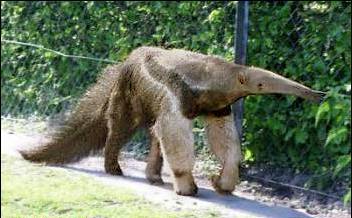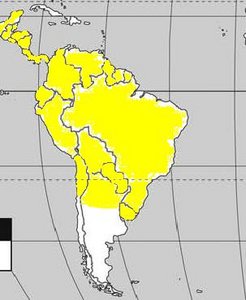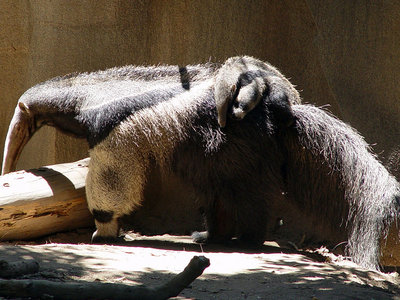Introduction


Myrmecophaga tridactyla, a giant anteater, captive at Aalborg Zoo, Denmark. Image © 2003 Malene Thyssen.
Classification of Giant Anteater
- Kingdom: Animalia
- Phylum: Chordata
- Class: Mammalia
- Order: Pilosa
- Family: Myrmecophagidae
- Genus: Myrmecophaga
- Species: M. tridactyla
- Binomial name: Myrmecophaga tridactyla Linnaeus, 1758
The giant anteater is classified in Animalia because it is multicellular, eukaryotic, and heterotrophic and digests its food in a stomach. The giant anteater is in the phylum Chordata because it’s a vertebrate and has a tail at the end of its body. Being in the class Mammalia means that the giant anteater has sweat glands and hair. Being in the family Myrmecophagide means that the giant anteater it is part of the anteater family.
Specific Adaptations to the Environment
The giant anteater lives in the rainforest and the grass lands of South America. They are very dependent on their environment, since their body temperature is very low, only between 32 and 35 °F.
Since the floor in the rainforest is very soft and muddy, they are able to walk on their knuckles instead of their paws, which protects their claws. The giant anteaters use their claws to protect themselves from predators, as for example jaguars or other meat eaters. They also use their claws to dig into termite or ant nests, and to dig themselves into the ground to sleep at night. If they ruin their claws it is hard for them to use them if they are needed.
Another adaptation of the giant anteater is their behaviour. They have an extremely strong sense for smelling their prey. The anteaters are able to smell 40 times better than humans can. This enables them to smell ants or termites from a long distance even up to several miles.
Their food intake is up to 30,000 ants a day. However this would not be possible without their extremely long and sticky tongue which has many spikes on it to help catch the prey. The total length the tongue can stretch is over two meters. The anteaters do not have teeth to reduce their food into small pieces, instead they have their powerful tongue to crunch their meal so that it is easier to digest.
The giant anteaters have light brown fur which helps them camouflage, and it also gives warmth to the animal.
General Description
Giant anteaters are a mixture of grey and brown colouring and grow to be 1 to 1.3 meters in length with a 64 to 90 centimetre bushy tail. A full grown giant anteater can weigh up to 39 kilograms and live up 26 years (in captivity). Giant anteaters like all anteaters are easily recognized by their small faces and eyes and long snout that they use to chew their food. Anteaters rely greatly on their sense of smell because they have bad eyesight and hearing.
- Grey and brown
- Length: 1-1.3 m
- Tail 64-90 cm
- Weight 22-39 kg
- Live up to 26 years in captivity (in wild?)
- Small face
- Small eyes
- Long snout
- Large front legs and front claws
- Walk on knuckles to protect claws
- Long bushy tail
- Long coarse fur
- Narrow body
- Long tongue
- Good sense of smell
- Bad sight and hearing
- Communicate through hisses and snorts
- Eat ants and termites
- Grubs
- Sometimes eat plants
Reproduction
Anteaters reproduce sexually like all mammals, and this suits their environment because they become less vulnerable to attack than if they would be if they split in half. To protect their children mother anteaters will carry their young on their backs.
Environment
Anteaters are important to their environment because they control the amounts of ants and termites thus protecting trees and making sure that too many termites do not destroy a forest.
Habitat
Giant anteaters reside in grasslands and deciduous rain forests of Central and South America where they hunt for ants and termites during the day in their 25 km2 home range.
- Grasslands and deciduous forest
- Rain forests
- Central and south America
- Day active
- 25 km2 home range


Map of Anteater Habitat © Chris Cadham
Animal Status
Giant anteaters are marked as vulnerable because they are hunted for food and fur and also are often hit by cars. Due to their size they have only the largest predators like pumas.
Pablo The Anteater


Giant anteater with child, captive at the San Diego Zoo. Image © © Howard Cheng.
Once upon a time there was an anteater named Pablo. Pablo the anteater had a family; he was the youngest of the bunch. His older sister’s name was Rosita and his older brother’s name was Jorge. When Pablo and his sibling were very young, their mother was in a tragic accident with a puma. Now the three young anteaters live with their mother’s sister, Aunt Ether.
Pablo woke up that day very hungry. He decided he really wanted to find a nice full ant nest and have a big breakfast. So Pablo started his journey through the damp Mexican rainforest. He searched for hours and hours but he could not find any ants for some reason. Just then his mean brother and sister stepped in.
“Where are all the ants in the ant nests?” asked Pablo.
“We ate them all so that there were none left for you!” snarled his brother, “And they were so good too. I’m really full now; I don’t think I need to eat for the rest of the day. I must have eaten tens of thousands of ants”, added Rosita
“You guys are mean! What am I supposed to eat then? I’m going to starve.” Cried Pablo, but his siblings just walked away. Pablo searched for a while longer, in different areas than he normally would, but he still couldn’t find any ants. The environment started to get drier and he noticed weird mounds sticking out of the ground. Eventually Pablo just collapsed.
While he was lying there resting, he opened his eyes and got a better look at these mounds. They were just big ugly piles of dirt. But just then, he saw a little spec crawl out of a hole and then run back in. An ant! Pablo wondered what they were doing in these strange mounds, so he stood up quickly and knocked the mound to the ground. There were thousand of them! Pablo dug right in. He stuck his long sticky tongue out and let the little insects crawl over it and when his tongue was covered; he slurped all of those delicious ants into his mouth.
After the first bite, he realized he wasn't eating ants! This was a completely different taste. It wasn’t a bad taste but it wasn’t the right one! Pablo spat out everything in his mouth and backed away scared trying to figure out what creatures he had just tried to eat. He turned around and started to run back towards the normal part of the forest but he bumped into someone.
“What do you think you are doing all the way out here young man? You know you’re not supposed to go beyond the boundaries we’ve set! Those rules are for your own safety.” Screamed his Aunt Ether.
“I’m so sorry Auntie, I know I broke the rules but I had to. Jorge and Rosita ate all of the ants in the forest just so I couldn’t have any. And I was really hungry this morning but there was no food so I had to come out here or I thought I would have starved.” Explained Pablo.
“I see. I’ll have to have a word with those two. Did you at least find something to eat?” She asked.
“Well sort of,” Pablo responded, “I found these weird mound things,” he said as he pointed his snout towards the one he had destroyed, “and I started eating whatever was inside them, but it was not ants. They didn’t taste bad but I know they weren’t ants and I got scared.”
“Let me have a look,” Aunt Ether said. She walked over to the broken mound and examined it for a while, and then laughed a little bit. “Oh, Pablo dear, don’t worry you can eat these, they are just termites.”
“What’s a ter-mite? I thought they were ants at first”
“Termites are kind of like ants except they eat wood and they live in these mounds. You can still eat them” she said sweetly.
“But I thought we were anteaters, not termite eaters. Isn't eating anything else, besides ants, not allowed?” questioned Pablo.
“No sweetie. We are just called anteaters because that is what we normally eat. We can eat termites too, they are actually quite tasty. Now come along, let’s have brunch together; there are plenty of mounds we can try out.”
So Pablo and Aunt Ether went from mound to mound eating more termites than Rosita and Jorge could ever have imagined. This became Pablo’s favourite feeding spot that he never told his brother or sister about so he could eat all the lovely termites for himself. The end.




 Go to quick links
Go to quick search
Go to navigation for this section of the ToL site
Go to detailed links for the ToL site
Go to quick links
Go to quick search
Go to navigation for this section of the ToL site
Go to detailed links for the ToL site